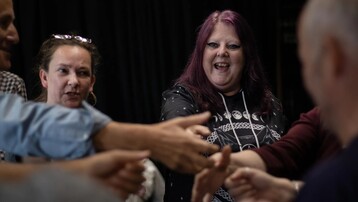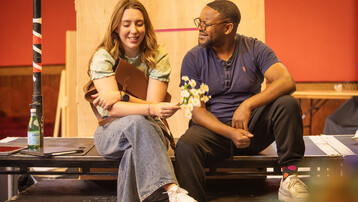Creating stories out of history: A closer look at the characters in Tutankhamun's Shoes
10 Nov 2022
News Story

This Autumn, English Touring Opera are touring our brand-new children's opera, Tutankhamun's Shoes, to schools, museums and theatres around the country. Tutankhamun's Shoes sends audiences back in time, to follow the story of King Tutankhamun's life, from a young pharaoh through to the discovery of his tomb. We visit characters such as Lady Carnarvon (who funded the dig for Tutankhamun's tomb), Tutankhamun's Uncle Ay,Howard Carter (the archeologist who excavated Tutankhamun's tomb) and Queen Pharaoh Nefertiti!
One character that we also follow throughout the story of Tutankhamun's Shoes is Meryt, who, in our story, crafts the sandals that were found in Tutankhamun's tomb. Created by our writer and ETO's General Director, Robin Norton-Hale, Meryt represents the figures in these stories, who have not been recorded by history. We recently sat down with Robin, and Judy Louie Brown (who is bringing Meryt to life on our tour!) to discuss placing a fictional character in a historical context.
Judy Louise Brown:
There's a line at the end of the show: "Though Meryt's not in any book She was kind, but she was poor; no-one built a tomb for her She lives on too Through his shoes."
Playing a fictional character not recorded by history is a different challenge to playing a 'real' person, there's less specific material to base your characterisation off, but it's liberating; you can research and get a general sense of how people of that economic level would have lived at the period, and because there's no definitive references to any one person, you make a lot of choices rooted in your own imagination. The shoes in Tut's tomb were made by someone, all the artefacts we see in museums were made and used and held by real living people whose names haven't been remembered, so you have to think about who they could have been, allow yourself to make decisions, then be really specific so it's clear and consistent.
I've loved building Meryt - few people make such a mark on the world so as to live on in history, and she's an example of a normal person, just one that lived 3,500 years ago. We start by working out the context, but everything else is invention and creation, which is so much fun and allows you to bring something really personal and (hopefully) identifiable to the character.
Robin Norton-Hale:
One of the challenges when writing a story based on real people and events from history is that most information about the past which has survived is about rich, ‘high status’ people, so we can get the impression that history is the story of kings and queens. That’s true of much more recent eras than ancient Egypt – think about the Tudor period, and it’s Henry VIII and Elizabeth I who probably spring to mind first. We know much less about ordinary people – but of course they were the majority.
Tutankhamun was a very wealthy King, remembered for the priceless treasure buried with him. But when I started researching his tomb, what struck me was that he was also buried with pairs of sandals specially made for his feet, to help him adapt to the disabilities that made it difficult for him to walk. It seemed to me that those shoes might have meant a lot more to Tutankhamun than all the gold.
This led me to wonder, ‘Who made Tutankhamun’s shoes?’. Of course, we don’t know, but someone did, and they were just as real as Tutankhamun himself. I’ve given Tutankhamun thoughts and feelings and words – all made up, but I hope they make him live for us. And to honour that unknown person who made his specially designed sandals, the character of Meryt was created, and she has thoughts and feelings and words which are just as important as Tutankhamun’s. Meryt celebrates the ordinary person who made something special.
You can find more information about Tutankhamun's Shoes, and our education work here.


